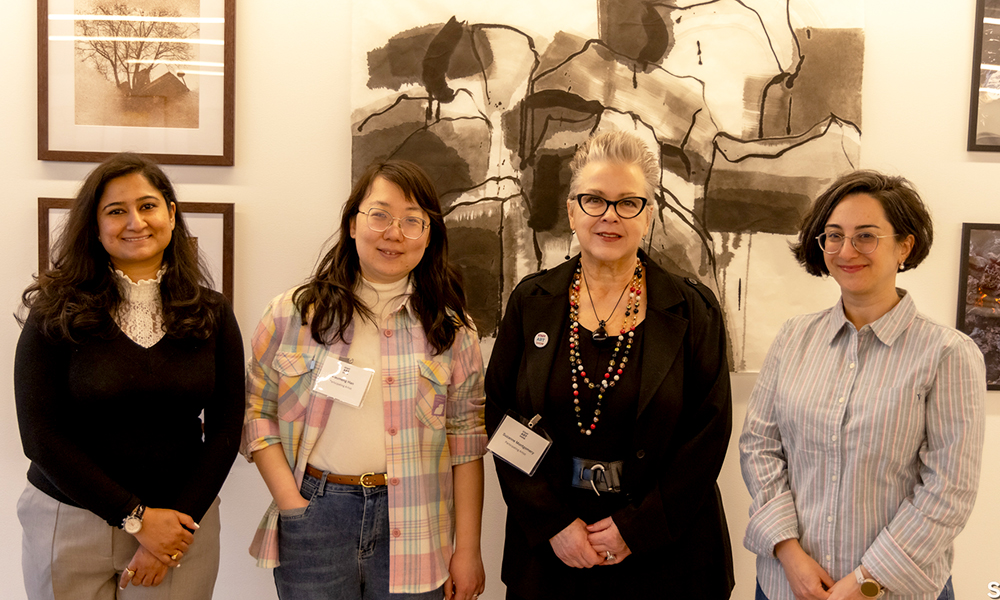Every year, the Harvard Art Show highlights the creativity of Harvard University staff through local shows. This year, the work of four MCB scientists is included in these juried art shows.
On Wednesday, May 8, Neha Karlupia, a postdoctoral fellow in the Lichtman lab, will display her creative pieces at the Gutman Library Harvard Art Show. A reception for the show﹘which runs through June 10﹘will take place from 3 to 7 p.m. Haleh Fotowat, a former postdoc in the Engert lab and now a scientist at the Wyss Institute, currently has her work on display at the Countway Library Harvard Art Show through July 8. Earlier in March, Xiaomeng Han, a postdoctoral fellow in the Dulac and Lichtman labs, and Suzanne Montgomery, the Lichtman lab’s administrative lab manager, presented their art at the Smith Campus Center Harvard Art Show.
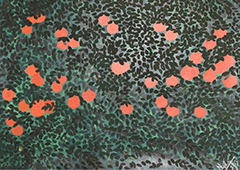
Neha Karlupia makes her art using layers upon layers of watercolors on canvas—a technique she developed herself. Her piece at the Gutman Gallery, Fruition, represents her approach to life, both in the lab and on the canvas.
“We tend to measure success in some form or dimension with a quantifiable aspect,” Neha explains. “And that is what is celebrated. But what about everything you went through to get to that point?” She also points out that success is rarely achieved alone; even a self-made person has support, perhaps not tangibly, but in other important ways.
Neha created the Fruition painting to capture both the successes and the paths to those successes. The literal fruits of the painting are the quantifiable successes one makes in life, but the leaves and stems – which make up most of the painting – support the fruit and represent the journey. “Endless pathways and endless people contributed to the fruition of goals in my life, and it is my way of expressing my gratitude to them,” she says.
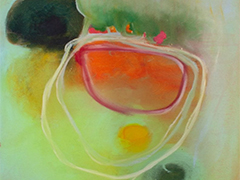
Haleh Fotowat left the Engert lab in 2021 for the Wyss Institute. Her featured work includes oil paintings on wood and wood panels, though she started with oil paintings on paper.
Haleh is a neuroscientist interested in brain function and how movement is generated. Many of her studies involved looking at animal movement, particularly spontaneously generated or unpredictable behaviors. “My paintings tended to start with just doing drawings letting my hand do whatever it wanted without any plan, just letting my hand draw trajectories,” she says. Her style was featured in a MCB Postdoc Spotlight story in 2021 . “The link to my science is that they both involve movement in general.”
Haleh’s current work involves more cellular-level microscopy and electron microscopy looking at structural details within cells. “At some point, I realized that my paintings started to look like some of the stuff that I’ve been looking at under the microscope,” she adds. I’ve never tried to copy things, but now I can see the connection which is why my most recent pieces are becoming more visually related to what I look at in the lab.”
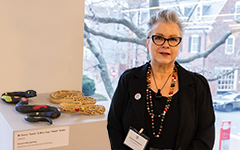
Suzanne Montgomery has created thousands of pieces, including pottery, jewelry, prints, and marbleized paper and fabric. Her work on display at the March show included several stoneware clay pieces, including two whimsical snakes with playful motifs. “I enjoy making these lighthearted designs which include big red lips, words, or unusual colors, and giving them as gifts,” says Suzanne, who learned many techniques after taking ceramics courses at Harvard. Several of her pieces are displayed throughout the Lichtman lab, which Suzanne has been a part of since 2014. (This is Suzanne’s second round with Harvard having previously been the lab administrator to Douglas A. Melton, then director of the Department of Stem Cell and Regenerative Biology, and current co-director of Harvard’s Stem Cell Institute.)
Suzanne’s love of art was, in fact, her professional work before coming to Harvard for the second time, having directed the Samford Institute of the Arts, the evening noncredit continuing education program in the arts offered at Samford University in Birmingham, Alabama.
Her extensive catalog of clay pots, platters, and wall hangings includes both glazed and unglazed pieces—most in browns and soft green tones but several in deep lapis. Her designs can be subtle, reflecting forms found in nature, or bold, with coils of beaded clay and heavily textured patterns.
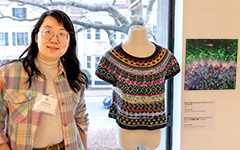
Xiaomeng Han currently focuses on knitting and crocheting, though she also has a strong background in creating both scientific and art illustrations. In the March show, she displayed two fiber arts pieces, a crochet shawl inspired by Beijing’s Hall of Supreme Harmony and a handcrafted sweater inspired by a fluorescence microscopy image she acquired during a project for her PhD.
“I have done so many shawls, socks, and even crocheted animal figures known as amigurumi that I give away to lab mates, friends, and family,” Han says. She has very recently started doing beading projects, like charms and earrings, and would like to return to doing more artistic illustrations. “I love to feel excited about new projects and new skills.”


